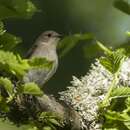 Multimedia w Wikimedia Commons
Multimedia w Wikimedia Commons Ficedula – rodzaj ptaka z podrodziny kląskawek (Saxicolinae) w rodzinie muchołówkowatych (Muscicapidae).
Zasięg występowania
Rodzaj obejmuje gatunki występujące w Eurazji i Afryce[6].
Morfologia
Długość ciała 9–14,5 cm; masa ciała 6–22,2 g[7].
Systematyka
Etymologia
-
Ficedula: łac. ficedula – mały, jedzący figi ptak, który przemieniał się zimą w kapturkę (Sylvia atricapilla)[8].
-
Muscicapula: zdrobnienie nazwy rodzajów Muscicapa Brisson 1760, muchołówka[9]. Gatunek typowy: Muscicapa sapphira Blyth, 1843.
-
Nitidula: łac. nitidulus – nieco elegancki, od nitidus – błyszczeć, od nitere – lśnić[10]. Gatunek typowy: Nitidula campbelli Blyth, 1861 = Nemura hodgsoni F. Moore, 1854.
-
Muscicapella: nowołac. muscicapella – muchołóweczka, od zdrobnienia nazwy rodzaju Muscicapa Brisson 1760, muchołówka[11]. Nowa nazwa dla Nitidula.
Podział systematyczny
Do rodzaju należą następujące gatunki[12]:
Przypisy
-
↑ Ficedula, w: Integrated Taxonomic Information System (ang.).
-
↑ M.J. Brisoon: Ornithologie, ou, Méthode contenant la division des oiseaux en ordres, sections, genres, especes & leurs variétés: a laquelle on a joint une description exacte de chaque espece, avec les citations des auteurs qui en ont traité, les noms quils leur ont donnés, ceux que leur ont donnés les différentes nations, & les noms vulgaires. T. 3. Parisiis: Ad Ripam Augustinorum, apud Cl. Joannem-Baptistam Bauche, bibliopolam, ad Insigne S. Genovesae, & S. Joannis in Deserto, 1760, s. 369. (łac. • fr.)
-
↑ E. Blyth. Mr. Blyth's monthly Report for December Meeting, 1842, with Addenda subsequently appended. „The Journal of the Asiatic Society of Bengal”. 12 (2), s. 939, 1843 (ang.).
-
↑ E. Blyth. Notes on some Birds collected by Dr. Jerdon in Sikkim. „Proceedings of the Zoological Society of London”. 29, s. 201, 1861 (ang.).
-
↑ V.L. Bianchi. Коллекція рыбъ, собранныхъ Н. А. Байковымъ въ Маньчжуріи, въ бассейне р. Мудань-цзяна. „Ежегодникъ Зооюгическаго Музея Імператоркоҋ Академіи Наукъ”. 12, s. 70, 1907 (ros.).
-
↑ F. Gill & D. Donsker: Chats, Old World flycatchers (ang.). IOC World Bird List: Version 7.1. [dostęp 2017-04-27].
-
↑ B. Coates, G. Dutson, Ch. Filardi, P. Clement, P. Gregory & K. Moeliker: Family Monarchidae (Monarch-flycatchers). W: J. del Hoyo, A. Elliott & D.A. Christie: Handbook of the Birds of the World. Cz. 11: Old World Flycatchers to Old World Warblers. Barcelona: Lynx Edicions, 2006, s. 129–131, 133, 135–138, 141–144, 162. ISBN 84-96553-06-X. (ang.)
-
↑ Jobling 2017 ↓, s. Ficedula.
-
↑ Jobling 2017 ↓, s. Muscicapula.
-
↑ Jobling 2017 ↓, s. Nitidula.
-
↑ Jobling 2017 ↓, s. Muscicapella.
-
↑ Systematyka i nazwy polskie za: P. Mielczarek & M. Kuziemko: Podrodzina: Saxicolinae Vigors, 1825 - kląskawki (wersja: 2017-03-31). W: Kompletna lista ptaków świata [on-line]. Instytut Nauk o Środowisku Uniwersytetu Jagiellońskiego. [dostęp 2017-04-27].
-
↑ P.C. Rasmussen & J.C. Anderton: Birds of South Asia: The Ripley Guide. Cz. 2. Waszyngton i Barcelona: Smithsonian Inst. and Lynx Edicions, 2005. ISBN 84-87334-67-9. (ang.)
-
↑ L. Svensson, J.M. Collinson, A.G. Knox, D.T. Parkin & G. Sangster. Species limits in the Red-breasted Flycatcher. „British Birds”. 98 (10), s. 538-541, 2005 (ang.).
-
↑ G.-P. Sætre, T. Borge & T. Moum. A new bird species? The taxonomic status of ‘the Atlas Flycatcher’ assessed from DNA sequence analysis. „Ibis”. 143 (4), s. 494-497, 2001. DOI: 10.1111/j.1474-919X.2001.tb04951.x (ang.).
-
↑ G.-P. Sætre, T. Borge, J. Lindell, T. Moum, C.R. Primmer, B.C. Sheldon, J. Haavie, A. Johnsen & H. Ellegren. Speciation, introgressive hybridization and nonlinear rate of molecular evolution in flycatchers: Molecular evolution in flycatchers. „Molecular Ecology”. 10 (3), s. 737-749, 2001. DOI: 10.1046/j.1365-294x.2001.01208.x (ang.).
-
↑ G.-P. Sætre, T. Borge, K. Lindroos, J. Haavie, B.C. Sheldoon, C.R. Primmer & A.-Ch. Syvänen. Sex chromosome evolution and speciation in Ficedula flycatchers. „Proceedings of the Royal of Society B”. 7 (270), s. 53-59, 2003. DOI: 10.1098/rspb.2002.2204 (ang.).
-
↑ R.G. Moyle, P.A. Hosner, A.W. Jones & D.C. Outlaw. Phylogeny and biogeography of Ficedula flycatchers (Aves: Muscicapidae): novel results from fresh source material. „Molecular Phylogenetics and Evolution”. 82, s. 87–94, 2015. DOI: 10.1016/j.ympev.2014.09.029 (ang.).
-
↑ D.C. Outlaw & G. Voelker. Systematics of Ficedula flycatchers (Muscicapidae): A molecular reassessment of a taxonomic enigma. „Molecular Phylogenetics and Evolution”. 41 (1), s. 118–126, 2006. DOI: 10.1016/j.ympev.2006.05.004 (ang.).
-
↑ D.C. Outlaw & G. Voelker. Pliocene climatic change in insular Southeast Asia as an engine of diversification in Ficedula flycatchers. „Journal of Biogeography”. 35 (4), s. 739-752, 2008. DOI: 10.1111/j.1365-2699.2007.01821.x (ang.).
Bibliografia
- J.A. Jobling: Key to Scientific Names in Ornithology. W: J. del Hoyo, A. Elliott, J. Sargatal, D.A. Christie & E. de Juana (red.): Handbook of the Birds of the World Alive. Barcelona: Lynx Edicions, 2017. [dostęp 2017-04-27]. (ang.)

